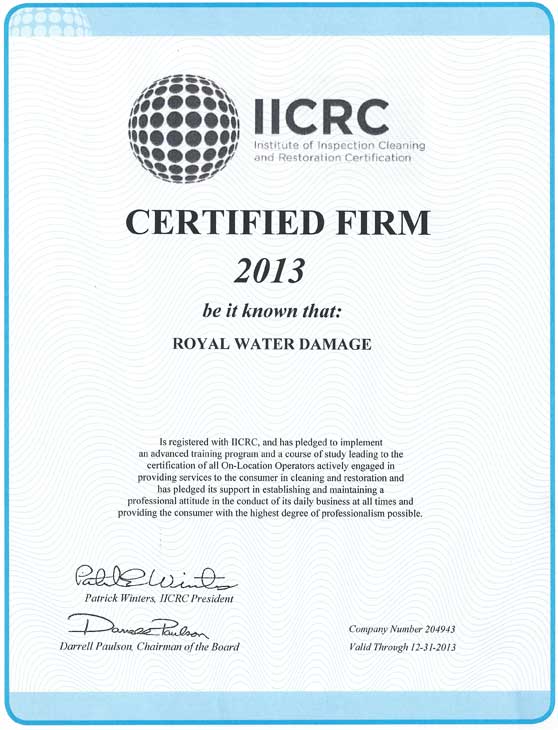
Royal Water Damage Restoration 215-657-2244
Homeowners insurance protects your home, its contents, and, indirectly, your other assets in the event of fires, theft, accidents or other disasters.
A standard homeowners policy (known as an HO-3 policy) will protect you from things like fires and fallen trees. Notice how we didn’t mention floods or earthquakes—those events are specifically not covered by a standard policy and require additional coverage. Homeowners in some areas of the country may be required by their mortgage company to carry these kinds of policies.
A standard policy will also protect your possessions from said disasters as well as theft. But a standard policy is not a blank check: There’s a limit to how much you’ll be compensated. If you have specific items of value, such as jewelry or artwork, you can pay a little extra each year to insure them for their full replacement value.
Now, if someone is on your property and slips and falls and sprains his ankle, he might sue you for his medical expenses. Homeowners insurance covers your liabilities in this situation as well. And like the examples mentioned above, you can pay more for extra coverage. Homeowners insurance isn’t required by law, like auto insurance. But mortgage companies usually require you to obtain a policy before they’ll give you a loan.
How Much Coverage Do You Need?
Your home insurance policy should cover enough to entirely rebuild and furnish your home were it wiped off the map. Ask a home builder to walk through your home and give you an estimate of what it would take to rebuild; that figure should be the basis for how much replacement coverage you’ll need. Be sure to point out any unique and/or expensive details that would add to the replacement cost.
Once you’ve determined the replacement cost of your home, you’ll need to know what kind of coverage you want. There are a few key terms here:
Guaranteed Replacement Cost Coverage. This means that the insurer will pay for the rebuilding of your home no matter the cost. These policies are hard to find these days.
Extended Replacement Coverage Many insurers offer coverage that caps the payout at around 125% of your home’s insured value.
Inflation Guarantee (or Guard). This feature makes sure that your home’s insured value stays current with the marketplace.
If you get a reliable appraisal, extended replacement coverage and an inflation guarantee, you should be in good shape. The appraisal provides a realistic starting figure and the inflation guarantee makes sure that your home’s price stays current. The 125% coverage means that, even if construction prices outpace inflation, they probably didn’t outpace it by 25%, so you should have enough money for whatever work you need done.
One last thing: The law requires you to have flood insurance if you live in an officially recognized high-risk area. To find out your flood risk and to find plans (which are offered by the government), go to floodsmart.gov.
When it comes to protecting your possessions, you may want more coverage than your standard policy allows. If you have anything of exceptional value (a family heirloom, a piece of art, jewelry, etc.), you should insure it separately. Insurers will charge extra for this coverage (something like an extra $10 on your monthly premium per $1,000 of value insured), but it pays to be covered.
Also keep in mind that there are two different kinds of coverage when it comes to personal articles. There’s “actual cash value” and there’s “replacement cost.” You want coverage for replacement cost. “Actual cash value” is what you’d get if you sold your valuable today — a lower amount than what you initially paid. “Replacement cost” pays you the amount of money you’d need to buy a brand-new item to replace your old one.
Liability Coverage
Say a guest stays at your home and slips on the floor and sprains his ankle. He decides to sue you. Your homeowners policy includes liability coverage in case you lose the court case. Generally speaking, standard policies offer $100,000 to $300,000 of liability coverage.
Supplemental liability coverage can boost your protection to $1 million or more. If you don’t own a car, adding that kind of coverage can be relatively cheap—less than $100 per year—and isn’t a bad idea. If you do own a car (putting you at greater risk for causing damage to people and property), expect to pay $300 to $400 a year. Check out your auto policy to see what kind of coverage you already have.
Shopping for a Homeowners Policy
There are three kinds of home insurance companies and salespeople:
Direct sellers, who sell directly to consumers (GEICO, Progressive and USAA fall into this category).
Captive agents, who only sell one company’s insurance products (for example, State Farm and Allstate agents).
Independent insurance agents, who sell policies from many different companies.
It’s possible that all of these groups will deny your insurance application for anything from the risky pool of alligators in your backyard or the tornado that runs through your property every year. Don’t despair. Many states have state-sponsored insurance programs for the hard-to-insure. Search for your state’s FAIR (Fair Access to Insurance Requirements) plan if you’re having a tough time with the traditional insurers.
Your Deductible
Like auto or health insurance, your homeowners insurance has a deductible (the amount you must pay before coverage kicks in). Like those other policies, you should opt for the highest deductible you can afford. If you do, the cost of your insurance premium (the monthly bill you pay) will surely be lower. Plus, a low deductible forces your insurer to cover more of your costs — costs they pass on to you in the form of increased premiums.
Remember: You should not use insurance to cover every conceivable expense, just the big ones. If reinstalling a gutter will cost you $200, pay the $200 — don’t start filing claims for it. Insurers hate it when you file too many claims, and may raise your monthly premium or even cancel coverage because they’ll view you as too risky. It’s not about gutters—you want the insurance when you have to pay for a whole new roof.
A good rule of thumb to follow: If you can fix anything for less than $1,000, don’t file a claim
Share on Facebook



